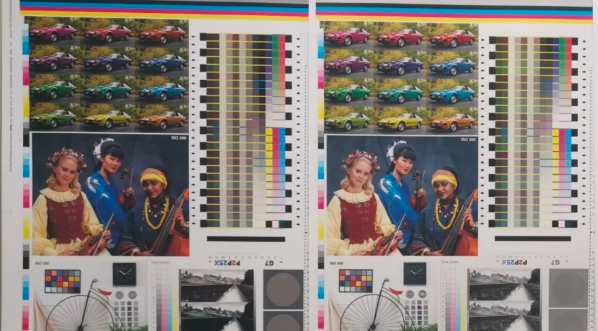What is the reason why digital samples are different from bulk samples?
Release Time:
24 Jun,2025
Do you often encounter such a problem? In printing production, there are differences between the products produced by digital proofing and traditional proofing. Friends who are new to printing may feel puzzled, but in fact, this is mainly due to the differences between the two in printing technology, material use, process flow, etc.
Do you often encounter such a problem? In printing production, there are differences between the products produced by digital proofing and traditional proofing. Friends who are new to printing may feel puzzled, but in fact, this is mainly due to the differences between the two in printing technology, material use, process flow, etc.
Digital samples are samples made based on digital printing equipment, with the characteristics of short production cycle, strong color expression and highly personalized customization. It abandons the traditional printing plate making process and directly converts digital files into printed products.
Massive samples are samples made before large-scale production. The important thing is to show the process, control quality and estimate costs. It is not only the key basis for testing product quality, but also an important link to ensure the correctness of the production process.

Technical differences
Digital proofing: mainly using inkjet printing technology, using inkjet printing equipment or professional digital proofing equipment. This technology can be directly output from computer files to paper or other substrates, with the advantages of fast, flexible and relatively low cost. This method is to use digitized originals (electronic files) to obtain proofing samples.
Traditional proofing: using traditional offset printing, the overall workflow includes: originals, customer requirements → design, color separation → output film → plate exposure → proofing → printing on the machine according to the sample (during which it may be necessary to re-plate, re-output and plate exposure) → post-processing (including lamination, oiling, polishing, hot stamping, embossing, cutting/beer cutting, folding, binding/mounting, etc.). It provides excellent image quality and cost-effectiveness for large-scale printing.
Material differences
Different paper: The paper or other substrates used for digital proofing may not be exactly the same as the materials used for the final mass production. The type, thickness, glossiness, etc. of the paper will affect the printing effect. Therefore, even the same design may present different visual effects on different materials. Take coated paper as an example. Coated paper for digital proofing is usually a special coated paper, which tends to be matte powder paper (mainly to reduce wear and tear on equipment), while the coated paper used for mass production is brighter than the paper for digital proofing.
Different inks: The ink used in the final mass production is also different from the ink used in digital proofing. Digital proofing generally uses special inks, while traditional proofing uses inks. The formula and drying method of the ink will affect the final printing color and texture.
Color gamut difference: Digital proofing is a mixture of at least 8 or 11 inks, while offset printing only has 4 inks. The color gamut of digital proofing sheets is generally larger than that of mass production. The color of digital proofing images is brighter and the color saturation is higher than that of mass printing.
Different thickness: Digital proofing is thicker than mass production. Because the mass goods are pressed by the paper laminating machine and the beer machine, the surface paper and the corrugated paper will fit more closely, so the thickness will appear thinner than the digital sample, but the hardness is the same.
Process Differences
Digital proofing is usually a relatively simple process, and the design file can be directly output. However, offset printing involves multiple steps, including pre-processing of the design draft, plate making, printing equipment debugging, printing, post-processing, etc. The subtle differences in each link may affect the final product.
In terms of color management, there may be differences in color reproduction between digital proofing and offset printing. Digital proofing can often restore the colors in the design file more accurately, but offset printing is affected by many factors such as ink, paper, and printing equipment, and the color reproduction may be biased.
Since it is not possible to achieve 100% similarity with the product, is digital proofing meaningless?
The answer is of course: it is meaningful!
The main purpose of the proofing link is to verify the feasibility and effect of the design and ensure that potential problems are discovered and resolved before formal production. Proofing can intuitively show whether the design content is correct. Because it is often difficult for us to see the problems of the design draft on the computer.
Environmental differences
Changes in temperature and humidity will directly affect the performance and stability of the material. For example, some materials may expand, deform or soften in high temperature or high humidity environments, and may become hard and brittle in low temperature or low humidity environments. This change may not be obvious in the proofing stage, but in mass production, due to differences in environmental conditions, it may cause significant changes in size, shape or performance. Especially in the production process of paper products, changes in environmental humidity have a great impact on the elasticity of paper, which may lead to unstable product dimensions.
Light and ultraviolet radiation have a degrading effect on certain materials (such as plastics, inks, etc.), and long-term exposure to these factors will cause material aging, discoloration or performance degradation. Proofing is usually in a well-controlled indoor environment, while the production site may face more complex lighting conditions, leading to differences in product quality.
In order to reduce the above differences, you can consider using the same paper and ink as the final production for digital proofing in the early stage of design to be closer to the actual production effect; conduct multiple test prints and adjustments before mass production to ensure that the printing effect meets expectations; strengthen communication with the printing factory to ensure that both parties have a clear understanding of the design requirements and printing process. This ensures that the color, texture, size, etc. of the final product are highly consistent with the design draft~
Related News
Add: No. 30-45 Huixi Road, Liangxi District, Wuxi, China
Follow us








